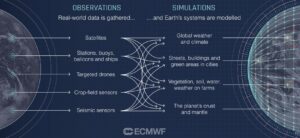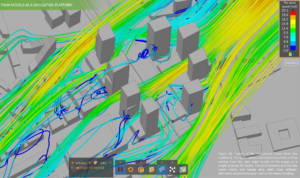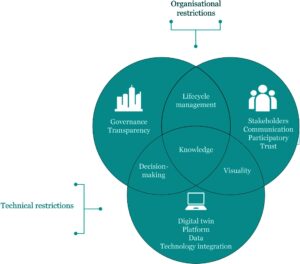Josephine Harris (Theme 6)
Digital twins are springing up everywhere, from agriculture, healthcare and urban planning to energy, finance and education. Josephine Harris provides an overview of what they are, where they are used, why they play an important role in sustainable development and how they are being made reality.

Complementary roles of digital twins and physical systems [16]
The Sustainable Development Goal transformation Digital Revolution for Sustainable Development [17] underpins all other transformations by playing a linchpin role in enabling and fast-forwarding efforts to achieve the 17 Sustainable Development Goals (SDGs) [21]. The digital revolution provides ever-expanding data collection, monitoring and analysis capabilities to aid more informed decision-making; democratises access to data and knowledge; designs technology to solve problems using innovative approaches; and creates tools for use by individuals and international institutions alike to more readily manage their own planning, operations, lifestyles and footprints. One such tool is digital twins.
What are digital twins and where are they used?
Digital twins are digital representations of physical systems. They are used to simulate, model, monitor, verify, control, analyse, diagnose, predict and train real-world systems based on real-life, and often real-time, data and scenarios. While they stem from the world of product design, digital twins are now used across a variety of industries and applications. To name a few: the aerospace industry uses them to optimise flight paths in both the ground-based control room and in the cockpit with the pilot[16]; energy resources and infrastructure are forecasted, planned and tested using digital twins[15]; and, with the future of medicine set to be personalised per patient, digital twins are helping map and simulate the body to a high level of precision and can combine data from wearables with historical health data to give precise and immediate treatment (see the human pancreas digital twin device used to treat diabetes mentioned in [12] and the innovations talked about in [13]). In short, digital twins are a key enabling technology in digitalisation AKA Industry 4.0.[19].
So, why now? What has enabled digital twins to become so invaluable?
Computer modelling has been around for decades (just think of CAD software coined in the 1950s[23] or the first Pixar short film released in 1986[5]), but the sheer computing power required to develop and run digital twins (and the money to pay for it) has, until recently, been lacking. With “increased availability of and access to powerful and inexpensive computing power, network, and storage”[16] and the increase in interoperability between physical and digital worlds through the development of IoT devices, digital twins have become a viable option for industry and research alike. Tie those together with a plethora of new data sources (anything from real-time asset monitoring tech such as LIDAR for micro-interaction data to new earth-observation satellites such as ESA’s Sentinel-6 (launched 2020) and NASA’s Landsat-9 (launched 2021) for global scale systems analysis) and advances in data visualisation techniques to quickly and accurately filter, distil and display information in real time and suddenly it is clear why digital twins are on trend right now.
How about some more real world examples?
In the grandest of grand ambitions, the EU, in collaboration with ESA, ECMWF and EUMETSAT, has set out to create a digital twin of the Earth.[20] Called Destination Earth (aptly, DestinE), this twin aims to be a “highly accurate digital model of the Earth [used] to monitor and predict the interaction between natural phenomena and human activities.”[8] It will use real-world observations gathered through a veritable plethora of sensors, both Earth-bound and space-bound (see the two images below), to feed Earth system models. These will be used to anticipate environmental disasters, monitor and simulate human interventions, and enable testing scenarios for sustainable development.[7] What is unique about DestinE is that it will combine environmental, socio-economic and human behaviour data into a single digital twin. This will make it a more complete representation of our world, enabling its results to be more accurate and realistic.

How the DestinE digital twin will work [6]

DestinE’s data lake and data sources [18]
On a slightly smaller scale, the city of Helsinki, striving to regain its top 3 position in the Smart City index (from #2 in 2020 to #6 in 2021)[2][1], recently developed a dynamic digital twin of the Kalasatama district with the goals of providing a digital platform for experiments prior to development happening in real life, making the models open source for other cities to benefit, and advancing “the use of digital twins in city processes and services.”[10] A key benefit of the twin and its data being open access is that new services can be built based on it by anyone. For example, an Energy and Climate Atlas[4] has been layered into the twin, using the included information about building surfaces to calculate and visualise the city’s current energy demand and renewable energy potential. This, in turn, can be used to decide where it is most effective to invest in renewable infrastructure such as solar panels on rooftops or façades. A wind simulation was also developed (see image below for snapshot of results) to aid urban planners and architects in mitigating the impacts of wind effects on the city microclimate and local residents.[3]

Kalasatama Digital Twin Project : sectional view of the airflow coming from the right edge (south) of the image at a height of about 50 metres [3]
The Helsinki project also inspired a research paper [9] in which digital twins are shown to “accelerate smart city experimentations and strengthen both learning and knowledge-based decision-making”.[9] The paper visualises how stakeholders, governments and technology come together within the context of smart cities as below, reiterating the importance of collaboration to sustainable development in urban environments.

A digital twin’s implications in the smart city context [9]
The use of digital twins for education and training is growing in popularity as well, particularly with the move to online learning necessitated by the Covid-19 pandemic. For example, they are used to train public transport operators[22], mechanics[11] and future engineers. You might have even used a digital twin in your studies at HSLU. If you participated in the EFPLAB modules during the pandemic, your “lab” time was spent online with digital twins of the fluid mechanics and thermodynamic experiments.[14]

Digital twin of the linear momentum equation experiment developed at HSLU [14]
So why are digital twins important to sustainable development? How do they contribute to the SDGs?
The contribution twins like DestinE have to the SDGs is clear: understand Earth’s global systems to inform direct climate action (SDG 13). Virtually modelling changes to urban infrastructure and planning before actually building anything can benefit both residents and future developers by ensuring developments are viable, sustainable, affordable and fair for the specific location and situation, directly contributing to SDGs 11: Sustainable Cities and Communities, 9: Industry, Innovationand Infrastructure, 7: Affordable and Clean Energy and 17: Partnerships for the Goals. As the authors of the Kalasatama Digital Twins Project report say: “Digital twin models at their best realize this idea of planning, testing and building things digitally first.”[3] The use of digital twins for training and education in any vocation that requires strategic and tactical problem solving and solution design (such as scientists, teachers, engineers, healthcare workers, planners, politicians, farmers, surgeons, parenthood, you name it!) can help instil the concepts and ethos of the SDGs from the earliest stage, leading to long term and broad reaching change in approaches to sustainable development, with direct contribution to SDGs 4: Quality Education and 8: Decent Work and Economic Growth.
In a broader sense, digital twins aid in deepening our understanding of the complex physical, natural and anthropogenic systems that underlie all the SDGs. By making use of powerful computer capabilities and intelligence in digital twins, we can enable and action informed change at all levels: from using climate models fed by real-time satellite data to warn farmers of impending storms and minimising crop loss (SDG 2: Zero Hunger) to forecasting energy demand for power generation optimisation of an electricity grid (SDG 7: Affordable and Clean Energy) and many more inbetween.
References
[1] Bris, A., Hean, C. K., Lanvin, B. (2021, October). Smart City Index 2021. Retrieved from https://www.imd.org/globalassets/wcc/docs/smart_city/smart_city_index2021.pdf
[2] City Executive Office. (2020, September 17). Helsinki ranks second in worldwide Smart City Index [Blog post]. City of Helsinki. Retrieved from https://www.hel.fi/uutiset/en/kaupunginkanslia/helsinki-ranks-second-in-worldwide-smart-city-in dex
[3] City Executive Office. (2019, May 2). The Kalasatama Digital Twins Project: The final report of the KIRA-digi pilot project. City of Helsinki. Retrieved from https://www.hel.fi/static/liitteet-2019/Kaupunginkanslia/Helsinki3D_Kalasatama_Digital_Twins.pdf
[4] City of Helsinki. (Accessed 2022, May 26). Energy and Climate Atlas. Helsinki. Retrieved from https://kartta.hel.fi/3d/atlas/#/
[5] Disney Pixar. (2022). Our Story. Pixar. Retrieved from https://www.pixar.com/our-story-pixar
[6] [ECMWF]. (2022, March 28). Digital Twin explainer animation [Video File]. Retrieved from https://www.youtube.com/watch?v=XLDm8VCLTqc
[7] EUMETSAT. (2022, March 31). Destination Earth. EUMETSAT. Retrieved from https://www.eumetsat.int/who-we-work/destine
[8] European Commision. (2022, March 31). Destination Earth. Shaping Europe’s digital future. Retrieved from https://digital-strategy.ec.europa.eu/en/policies/destination-earth
[9] Hämäläinen, M. (2021). Urban development with dynamic digital twins in Helsinki city. IET Smart Cities, 3(4), 201– 210. https://doi.org/10.1049/smc2.12015
[10] Heiskanen, A. (2019, April 15). Helsinki is Building a Digital Twin of the City [Blog post]. Retrieved from https://aec-business.com/helsinki-is-building-a-digital-twin-of-the-city/
[11] igal. (2021, January 4). Virtual Training: How Digital Twins and VR are Bridging the Gap Between Learning and Doing [Blog post]. Retrieved from https://frontline.io/digital-twins-and-vr-training/
[12] Jackson, A. (2022, February 24). Medical Digital Twins: a New Frontier [Blog post]. Retrieved from https://cacm.acm.org/news/258948-medical-digital-twins-a-new-frontier/fulltext
[13] Lawton, G. (2021, July 4). 21 ways medical digital twins will transform healthcare [Blog post]. Retrieved from https://venturebeat.com/2021/07/04/21-ways-medical-digital-twins-will-transform-healthcare/
[14] Müller, U., Deniz, S. (2021). Digital Twins in teaching [Blog post]. Retrieved from https://www.hslu.ch/en/lucerne-school-of-engineering-architecture/about-us/organization/compe tence-centres-and-research-groups/engineering-and-technology/fluidmechanik-hydromaschinen/ dynamische-stroemungs-und-prozesssimulationen/digital-twins-in-der-lehre/
[15] O’Dwyer, E., Pan, I., Charlesworth, R., Butler, S., Shah, N. (2020). Integration of an energy management tool and digital twin for coordination and control of multi-vector smart energy systems. Sustainable Cities and Society, 62. https://doi.org/10.1016/j.scs.2020.102412
[16] Parrott, A., Umbenhauer, B., Warshaw, L., et al. (2020, January 15). Digital twins: Bridging the physical and digital. Deloitte Insights. Retrieved from https://www2.deloitte.com/uk/en/insights/focus/tech-trends/2020/digital-twin-applications-bridgi ng-the-physical-and-digital.html
[17] Sachs, J.D., Schmidt-Traub, G., Mazzucato, M. et al. (2019). Six Transformations to achieve the Sustainable Development Goals. Nature Sustainability, 2, 805–814. https://doi.org/10.1038/s41893-019-0352-9
[18] Saracco, R. (2021, June 20). As big as it gets: Earth Digital Twin [Blog post]. Retrieved from https://cmte.ieee.org/futuredirections/2021/06/20/as-big-as-it-gets-earth-digital-twin/
[19] Steindl, G., Stagl, M., Kasper, L., Kastner, W., Hofmann, R. (2020). Generic Digital Twin Architecture for Industrial Energy Systems. Applied Sciences, 10(24). https://doi.org/10.3390/app10248903
[20] Ulmer, S. (2021, March 9). Scientists are building a digital twin of the Earth to fight climate change [Blog post]. Retrieved from https://www.weforum.org/agenda/2021/03/scientists-are-developing-a-digital-twin-of-our-earth-t o-fight-climate-change/
[21] United Nations. (Accessed 2022, May 26). Do you know all 17 SDGs?. United Nations Department of Economic and Social Affairs: Sustainable Development. Retrieved from https://sdgs.un.org/goals
[22] Wanek-Libman, M. (2019, February 8). Digital twins – the secret to safe training? [Blog post]. Retrieved from https://www.masstransitmag.com/technology/intelligent-transportation-systems/article/1300000 9/digital-twins-the-secret-to-safe-training
[23] (2022, April 19). History of CAD software. Wikipedia. Retrieved from https://en.wikipedia.org/wiki/History_of_CAD_software
Further reading
Destination Earth launch event
Destination Earth – new digital twin of the Earth will help tackle climate change and protect nature
Generic Digital Twin Architecture for Industrial Energy Systems
Helsinki’s digital twin and city models
Integration of an energy management tool and digital twin for coordination and control of multi-vector smart energy systems – ScienceDirect
Two US national labs developing Digital Twins for Hydropower framework
(use APA Style for referencing, BW)